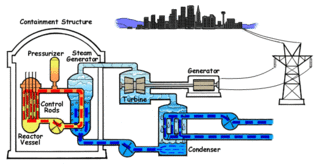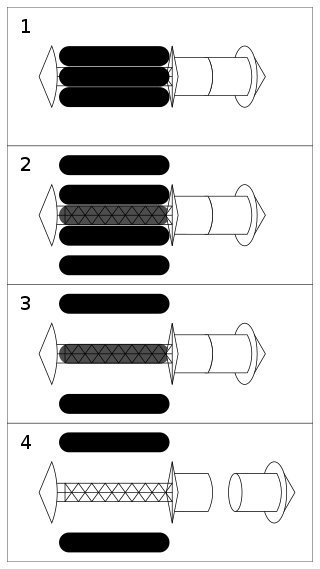Related Research Articles

Interstellar travel is the hypothetical travel of spacecraft from one star system, solitary star, or planetary system to another. Interstellar travel is expected to prove much more difficult than interplanetary spaceflight due to the vast difference in the scale of the involved distances. Whereas the distance between any two planets in the Solar System is less than 30 astronomical units (AU), stars are typically separated by hundreds of thousands of AU, causing these distances to typically be expressed instead in light-years. Because of the vastness of these distances, non-generational interstellar travel based on known physics would need to occur at a high percentage of the speed of light; even so, travel times would be long, at least decades and perhaps millennia or longer.

A nuclear thermal rocket (NTR) is a type of thermal rocket where the heat from a nuclear reaction, often nuclear fission, replaces the chemical energy of the propellants in a chemical rocket. In an NTR, a working fluid, usually liquid hydrogen, is heated to a high temperature in a nuclear reactor and then expands through a rocket nozzle to create thrust. The external nuclear heat source theoretically allows a higher effective exhaust velocity and is expected to double or triple payload capacity compared to chemical propellants that store energy internally.
A nuclear salt-water rocket (NSWR) is a theoretical type of nuclear thermal rocket which was designed by Robert Zubrin. In place of traditional chemical propellant, such as that in a chemical rocket, the rocket would be fueled by salts of plutonium or 20 percent enriched uranium. The solution would be contained in a bundle of pipes coated in boron carbide. Through a combination of the coating and space between the pipes, the contents would not reach critical mass until the solution is pumped into a reaction chamber, thus reaching a critical mass, and being expelled through a nozzle to generate thrust.
Beam-powered propulsion, also known as directed energy propulsion, is a class of aircraft or spacecraft propulsion that uses energy beamed to the spacecraft from a remote power plant to provide energy. The beam is typically either a microwave or a laser beam and it is either pulsed or continuous. A continuous beam lends itself to thermal rockets, photonic thrusters and light sails, whereas a pulsed beam lends itself to ablative thrusters and pulse detonation engines.
In a traditional nuclear photonic rocket, an onboard nuclear reactor would generate such high temperatures that the blackbody radiation from the reactor would provide significant thrust. The disadvantage is that it takes much power to generate a small amount of thrust this way, so acceleration is very low. The photon radiators would most likely be constructed using graphite or tungsten. Photonic rockets are technologically feasible, but rather impractical with current technology based on an onboard nuclear power source.

A fusion rocket is a theoretical design for a rocket driven by fusion propulsion that could provide efficient and sustained acceleration in space without the need to carry a large fuel supply. The design requires fusion power technology beyond current capabilities, and much larger and more complex rockets.

An antimatter rocket is a proposed class of rockets that use antimatter as their power source. There are several designs that attempt to accomplish this goal. The advantage to this class of rocket is that a large fraction of the rest mass of a matter/antimatter mixture may be converted to energy, allowing antimatter rockets to have a far higher energy density and specific impulse than any other proposed class of rocket.

A starship, starcraft, or interstellar spacecraft is a theoretical spacecraft designed for traveling between planetary systems. The term is mostly found in science fiction. Reference to a "star-ship" appears as early as 1882 in Oahspe: A New Bible.

Nuclear pulse propulsion or external pulsed plasma propulsion is a hypothetical method of spacecraft propulsion that uses nuclear explosions for thrust. It originated as Project Orion with support from DARPA, after a suggestion by Stanislaw Ulam in 1947. Newer designs using inertial confinement fusion have been the baseline for most later designs, including Project Daedalus and Project Longshot.
Antimatter-catalyzed nuclear pulse propulsion is a variation of nuclear pulse propulsion based upon the injection of antimatter into a mass of nuclear fuel to initiate a nuclear chain reaction for propulsion when the fuel does not normally have a critical mass.

Project Orion was a study conducted in the 1950s and 1960s by the United States Air Force, DARPA, and NASA for the purpose of measuring the efficacy of a starship directly propelled by a series of explosions of atomic bombs behind the craft: nuclear pulse propulsion. Early versions of this vehicle were proposed to take off from the ground; later versions were presented for use only in space. Six non-nuclear tests were conducted using models. The project was eventually abandoned for multiple reasons, including the Partial Test Ban Treaty, which banned nuclear explosions in space, and concerns over nuclear fallout.

Nuclear propulsion includes a wide variety of propulsion methods that use some form of nuclear reaction as their primary power source. The idea of using nuclear material for propulsion dates back to the beginning of the 20th century. In 1903 it was hypothesized that radioactive material, radium, might be a suitable fuel for engines to propel cars, planes, and boats. H. G. Wells picked up this idea in his 1914 fiction work The World Set Free. Many aircraft carriers and submarines currently use uranium fueled nuclear reactors that can provide propulsion for long periods without refueling. There are also applications in the space sector with nuclear thermal and nuclear electric engines which could be more efficient than conventional rocket engines.

Laser propulsion is a form of beam-powered propulsion where the energy source is a remote laser system and separate from the reaction mass. This form of propulsion differs from a conventional chemical rocket where both energy and reaction mass come from the solid or liquid propellants carried on board the vehicle.

Project Daedalus was a study conducted between 1973 and 1978 by the British Interplanetary Society to design a plausible uncrewed interstellar probe. Intended mainly as a scientific probe, the design criteria specified that the spacecraft had to use existing or near-future technology and had to be able to reach its destination within a human lifetime. Alan Bond led a team of scientists and engineers who proposed using a fusion rocket to reach Barnard's Star 5.9 light years away. The trip was estimated to take 50 years, but the design was required to be flexible enough that it could be sent to any other target star.

Project Longshot was a conceptual interstellar spacecraft design. It would have been an uncrewed starship, intended to fly to and enter orbit around Alpha Centauri B powered by nuclear pulse propulsion.

An interstellar probe is a space probe that has left—or is expected to leave—the Solar System and enter interstellar space, which is typically defined as the region beyond the heliopause. It also refers to probes capable of reaching other star systems.
A pure fusion weapon is a hypothetical hydrogen bomb design that does not need a fission "primary" explosive to ignite the fusion of deuterium and tritium, two heavy isotopes of hydrogen used in fission-fusion thermonuclear weapons. Such a weapon would require no fissile material and would therefore be much easier to develop in secret than existing weapons. Separating weapons-grade uranium (U-235) or breeding plutonium (Pu-239) requires a substantial and difficult-to-conceal industrial investment, and blocking the sale and transfer of the needed machinery has been the primary mechanism to control nuclear proliferation to date.
ICAN-II was a proposed crewed interplanetary spacecraft that used the antimatter-catalyzed micro-fission (ACMF) engine as its main form of propulsion. The spacecraft was designed at Penn State University in the 1990s as a way to accomplish a crewed mission to Mars. The proposed ACMF engine would require only 140 nanograms of antiprotons in conjunction with traditional fissionable fuel sources to allow a one-way transit time to Mars of 30 days. This is a considerable improvement over many other forms of propulsion that can be used for interplanetary missions, due to the high thrust-to-weight ratio and specific impulse of nuclear fuels. Some downsides to the design include the radiation hazards inherent to nuclear pulse propulsion, as well as the limited availability of the antiprotons used to initialize the nuclear fission reaction. Even the small amount required by the ACMF engine is equal to the total antimatter production at the facilities CERN and Fermilab over many years, although these create antimatter only as a byproduct of physics experiments, not as a goal. ICAN-II is similar to the Project Orion design put forth by Stanislaw Ulam in the late 1950s. The Orion was intended to be used to send humans to Mars and Venus by 1968. The ICAN-II also, in a sense, utilizes nuclear "bombs" for thrust. However, instead of regular fission bombs like the Orion would utilize, ICAN-II uses what are, essentially, many tiny hydrogen bombs, set off by a stream of anti-protons. Ecological concerns would probably require that ICAN-II be assembled in space.
Mini-Mag Orion (MMO), or Miniature Magnetic Orion, is a proposed type of spacecraft propulsion based on the Project Orion nuclear propulsion system. The Mini-Mag Orion system achieves propulsion by compressing fissile material in a magnetic field, a Z-pinch, until fission occurs. This fission reaction propels the craft. MMO should be able to propel 100 tons to Mars within 3 months or to Jupiter in about one year.

Nuclear power in space is the use of nuclear power in outer space, typically either small fission systems or radioactive decay for electricity or heat. Another use is for scientific observation, as in a Mössbauer spectrometer. The most common type is a radioisotope thermoelectric generator, which has been used on many space probes and on crewed lunar missions. Small fission reactors for Earth observation satellites, such as the TOPAZ nuclear reactor, have also been flown. A radioisotope heater unit is powered by radioactive decay and can keep components from becoming too cold to function, potentially over a span of decades.
References
- ↑ Lewis, Raymond A; Meyer, Kirby; Smith, Gerald A; Howe, Steven D. "AIMStar: Antimatter Initiated Microfusion For Pre-cursor Interstellar Missions" (PDF). Archived from the original (PDF) on June 16, 2014.
- ↑ Antimatter Production for Near-term Propulsion Applications "Archived copy" (PDF). Archived from the original (PDF) on 2007-03-06. Retrieved 2013-05-24.
{{cite web}}: CS1 maint: archived copy as title (link)
